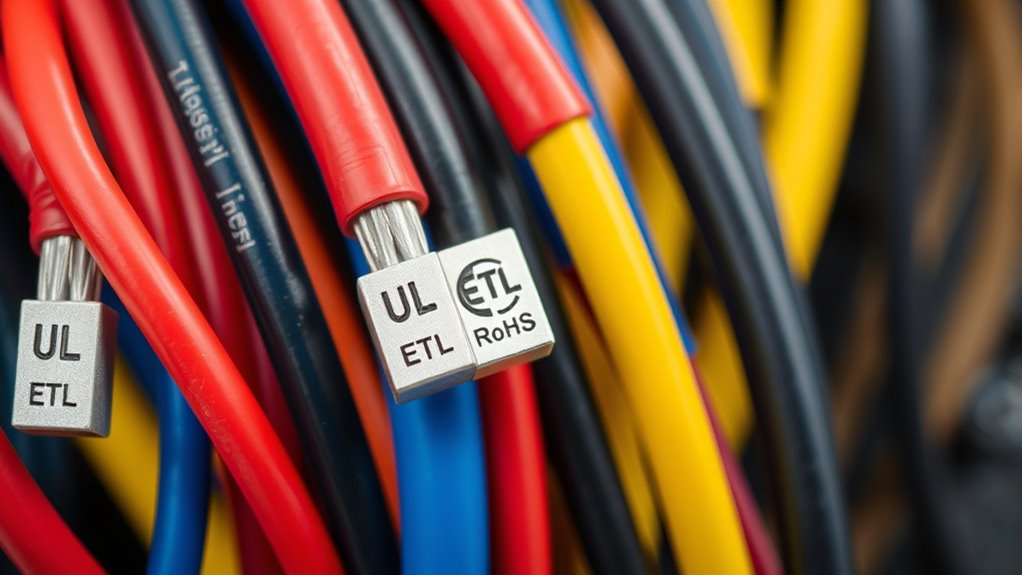Understanding cable certifications like UL, ETL, and RoHS helps you identify safe, reliable products that meet strict safety, environmental, and quality standards. UL and ETL certify that cables have passed rigorous testing for safety and durability, while RoHS ensures they comply with restrictions on hazardous substances. Recognizing these labels gives you confidence in your choices. Keep exploring to learn how these certifications impact your safety and compliance decisions even further.
Key Takeaways
- UL and ETL are safety testing organizations that certify cables meet electrical and fire safety standards.
- RoHS certification ensures cables comply with restrictions on hazardous substances, supporting environmental safety.
- Certifications verify that cables have undergone rigorous testing for durability, safety, and environmental impact.
- Recognized certifications help consumers and manufacturers confirm product compliance with international safety norms.
- Understanding these certifications aids in making informed purchasing decisions and ensures legal market access.

Have you ever wondered what makes a cable safe and reliable for your specific needs? When it comes to choosing the right cable, understanding certifications like UL, ETL, and RoHS is essential. These certifications serve as proof that the cable meets strict safety standards and compliance requirements established by reputable organizations. They help ensure that the product has been tested for durability, electrical safety, and environmental impact, giving you confidence in its performance. Additionally, knowing the asset division principles can help you understand the importance of thorough testing and documentation in certifying products.
Frequently Asked Questions
How Often Do Cable Certifications Need Renewal or Updates?
You should check your cable certifications regularly, as certification renewal and updating certification are typically required every 1 to 3 years, depending on the certifying agency and product changes. Stay proactive by monitoring your certificates and ensuring compliance with current standards. If regulations or product specifications change, you’ll need to update certification promptly to maintain certification validity and market access. Regular updates help you avoid potential compliance issues or product recalls.
Are There Regional Differences in Certification Requirements?
You might think certification standards are the same worldwide, but regional standards vary markedly. Certification variations exist because different regions prioritize specific safety, environmental, and quality standards. For example, UL certifications are common in North America, while CE marks are required in Europe. These regional differences influence testing, documentation, and compliance processes, so you’ll need to guarantee your cables meet each area’s specific certification requirements to operate legally and safely across markets.
Can Uncertified Cables Be Safely Used in Certain Applications?
Uncertified cables can pose serious safety risks and may not satisfy legal compliance standards, depending on your application. Using them could lead to electrical failures, fires, or injuries, especially if regulations require certified products. Always check local codes and safety guidelines before opting for uncertified cables. In critical or regulated environments, certified cables are essential to ensure safety, prevent legal issues, and maintain reliable operation.
What Are the Penalties for Using Non-Certified Cables?
Using non-certified cables is like sailing uncharted waters—riskier than you might think. You could face hefty legal liabilities if safety concerns lead to accidents or damages, and you might be held responsible for any injuries or property loss. Penalties can include fines, lawsuits, or equipment seizure. To avoid these dangers, always guarantee your cables meet certification standards, protecting both your business and your safety.
How Can Consumers Verify a Cable’s Certification Authenticity?
You can verify a cable’s certification authenticity by inspecting the product labeling for clear certification logos like UL, ETL, or RoHS. Check that these logos are genuine and match official images from certifying organizations. Also, verify the certification number or code if available, by visiting the certifier’s website. These steps guarantee you’re buying a cable that meets safety and environmental standards, giving you peace of mind.
Conclusion
Now that you understand cable certifications like UL, ETL, and RoHS, you see how they guarantee safety and compliance. While these labels promise reliability, they also remind you that not all cables are created equal—some prioritize safety, others environmental impact. Choosing the right cable isn’t just about certifications; it’s about trusting what’s beneath the surface. So, look beyond the labels, and select cables that truly meet your needs and standards.




